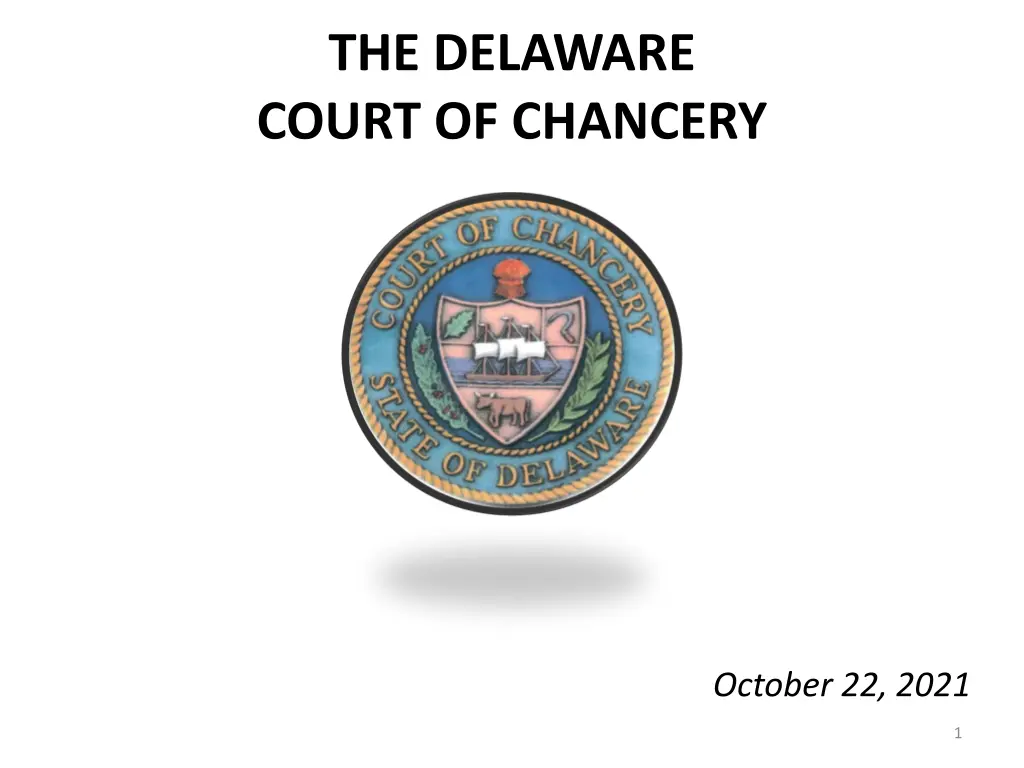
Delaware Court of Chancery Formation and Historical Highlights
Learn about the formation of the Delaware Court of Chancery in 1792 and its historical significance in corporate law. Discover how Delaware has become a hub for entity formation, hosting millions of corporations and contributing significantly to the state's revenue through entity formation.
Download Presentation

Please find below an Image/Link to download the presentation.
The content on the website is provided AS IS for your information and personal use only. It may not be sold, licensed, or shared on other websites without obtaining consent from the author. If you encounter any issues during the download, it is possible that the publisher has removed the file from their server.
You are allowed to download the files provided on this website for personal or commercial use, subject to the condition that they are used lawfully. All files are the property of their respective owners.
The content on the website is provided AS IS for your information and personal use only. It may not be sold, licensed, or shared on other websites without obtaining consent from the author.
E N D
Presentation Transcript
THE DELAWARE COURT OF CHANCERY October 22, 2021 1
When was the Delaware Court of Chancery formed? A. 1787 B. 1792 C. 1899 D. 1776 2
When was the Delaware Court of Chancery formed? A. 1787 B. 1792 C. 1899 D. 1776 A. Delaware Day B. Court of Chancery C. Corporation Law D. Separation Day 3
1792 Creation of the Delaware Court of Chancery 1897 Article IX of the Constitution of 1897 1899 General corporation law (DGCL) enacted to compete with New Jersey The Delaware Court of Chancery and Corporation 1913 NJ enacts the Seven Sisters Act effectively outlawing trusts and holding companies an opening for Delaware. 1917 Delaware begins ascendancy in entity formation 1967 Significant revision of DGCL; annual review 1980s The Court s unique role in takeover litigation 1982 Enactment of the Delaware Revised Uniform Limited Partnership Act; substantial revisions of DRULPA in 1985 1992 Enactment of LLC Act 2017 225th/50th/25th Anniversaries Law Historical Highlights 4
How many entities have been formed in Delaware? A. 250,000,000 B. 1,700,000 C. 990,000 D. 100,000 5
How many entities have been formed in Delaware? A. 250,000,000 A. B. 1,700,000 B. C. 990,000 C. D. 100,000 D. 6
1.7 million entities Largely publicly traded corporations and subsidiaries Stand alone small corporations Growth in alternative entities (LLC s, LP s) Entity Formation Delaware incorporations include: 67.6% of Fortune 500 companies 7
Entity formation accounts for what percentage of the state s revenue? A. 17% B. 22% C. 27% D. 32% 8
Entity formation accounts for what percentage of the state s revenue? A. 17% B. 22% C. 27% D. 32% 9
Court of Chancery 4-Year Civil Caseload Trend Caseload 1,400 1,200 38% of New Filings Include Motions to Expedite 1,000 800 600 400 200 - 2018 959 973 2019 1,167 987 2020 1,144 875 2021 1,193 1,106 Filings Dispositions Fiscal Year 10
Trial court that hears and determines all matters in equity. Three sources of jurisdiction Jurisdiction Equitable claims-fiduciary relationships Equitable relief-TROs, injunctions, specific performance Statutory grants of authority 11
1792 1939 The Court consisted of only a single Chancellor 1939 A Vice Chancellor is established by statute Evolution of the Court 1946 Vice Chancellor becomes a constitutional office 1961 A second Vice Chancellor is added 1984 A third Vice Chancellor is added 1989 A fourth Vice Chancellor is added 2018 Two more Vice Chancellors are added 12
Officers of the Court Seven Constitutional officers nominated by the Governor and confirmed by the Senate: the Chancellor and six Vice Chancellors. Two Masters. 13
What is the Chancellor unable to do? A. Authorize a blood transfusion B. Recommend a pardon for a crime C. Set aside a jury verdict D. Declare someone to be dead 14
What is the Chancellor unable to do? A. Authorize a blood transfusion B. Recommend a pardon for a crime C. Set aside a jury verdict D. Declare someone to be dead 15
Guardianships adult, property The Human Side of Chancery Unusual remedies Blood transfusion DNR Order Presumption of death Board of Pardons 16
No juries, no punitives Over a century of well-developed precedent The enabling nature of the DGCL with overlay of common law review Why Chancery? Ability to fashion equitable remedies Experience and expertise of judicial officers A commitment to prompt dispositions and excellence 17
CURRENT ISSUES FOR THE COURT OF CHANCERY AND DELAWARE CORPORATE LAW A. Workload 1. Growing Dockets More corporations and alternative entities means more litigation Statutory jurisdiction steadily expanded Chancery is the court companies want to be in 2. Market expectations 3. Books and records actions The use of the tools at hand approach is more prevalent because of higher pleading standards and lead counsel disputes The function of Section 220 has changed in the era of increased SEC disclosure and the internet 18
CURRENT ISSUES FOR THE COURT OF CHANCERY AND DELAWARE CORPORATE LAW B. The Contractualization of Entity Law and the Court of Chancery 1. Altering the corporate contract Bylaws Certificate provisions 2. Statutory amendments 3. Case law adapting equitable principles 19
CURRENT ISSUES FOR THE COURT OF CHANCERY AND DELAWARE CORPORATE LAW C. Potential Threats to Delaware s Dominance 1. Federal encroachment 2. State Competition 3. Arbitration 4. Fee shifting 20
